Pasta is a highly handy staple for many of us, but if you’ve received a diabetes diagnosis, you may not be able to indulge in this ingredient as much as you did previously.
The good news is that there are substitutes for pasta that you can enjoy.
The best healthy pasta alternatives for diabetics tend to be:
- Kelp noodles (Seaweed pasta)
- Eggplant lasagna
- Soba noodles
- Veggie spaghetti
- Cabbage noodles
In this article, I’ll explore the best substitutes in much more detail.
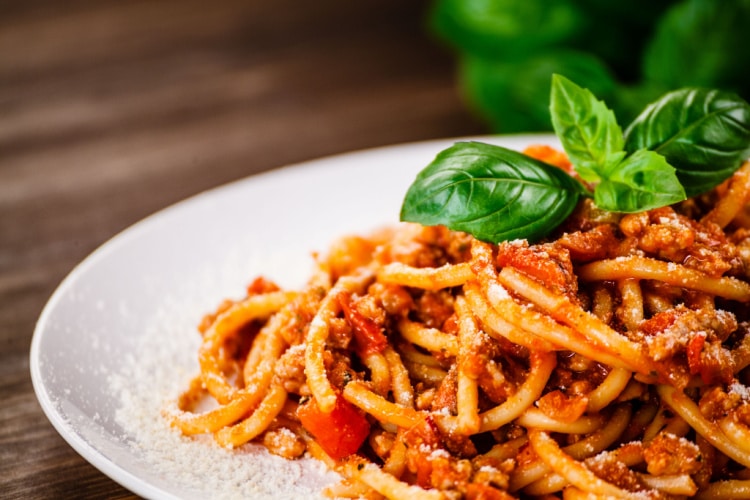
The Healthiest Pasta Alternatives For Diabetics
Diabetics must manage their blood sugar levels carefully to avoid complications associated with high glucose levels.
Traditional pasta, made primarily from refined flour, is high in carbohydrates, which the body breaks down into sugars, leading to rapid increases in blood sugar levels.
This can be particularly challenging for diabetics, as their bodies have difficulty processing and regulating these sugar spikes efficiently.
The lack of fiber in regular pasta also contributes to its quick digestion, exacerbating the rapid rise in glucose.
Consequently, consuming pasta can make it harder for diabetics to maintain stable blood sugar levels, necessitating alternatives that have a lower glycemic impact.
Below, I’ll talk more about the 5 substitutes I mentioned earlier.
1. Kelp Noodles (Seaweed Pasta)
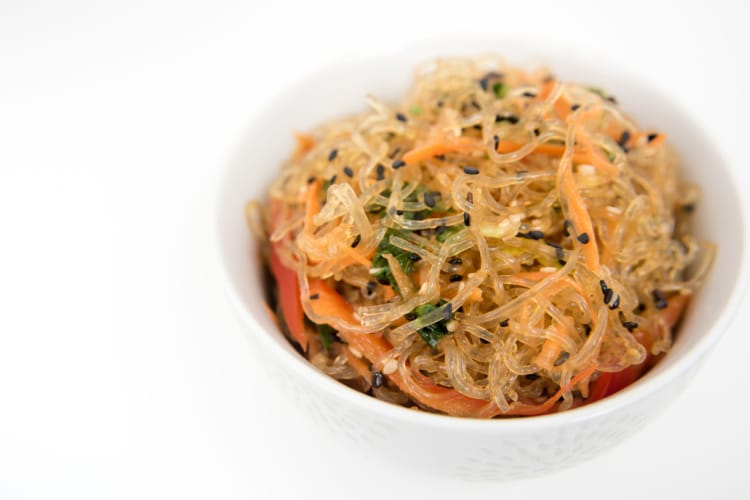
Hailing from the depths of the sea, kelp makes a tasty and nutritious pasta alternative for diabetics.
The unusual shape and texture of the noodles may appear a little strange, but you’ll be glad you tried them.
In terms of blood sugar, kelp has a low glycemic index. It prevents glucose levels from soaring as they would if you had regular spaghetti.
Kelp contains various nutrients, including vitamin K, folate, magnesium, iron, vitamin A, pantothenic acid, and calcium. One serving contains 6 calories, 1.3 g of carbohydrates, 0.2 g of dietary fiber, 0.1 g of fat, and 0.2 g of protein.
How To Make Kelp Noodles
There are two kinds of kelp noodles — clear and green-colored.
Most people like clear kelp because the taste and texture are similar to regular pasta, as opposed to green kelp, which has a more robust seaweed flavor.
The best part is that you don’t have to cook kelp. Start by washing it thoroughly. Then, add it to a bowl of warm water, squeeze lemon juice, and season with salt.
Allow it to rest for 30 minutes before rinsing, straining, and serving with roasted vegetables, meat, seafood, or a luscious noodle sauce.
2. Eggplant Lasagna
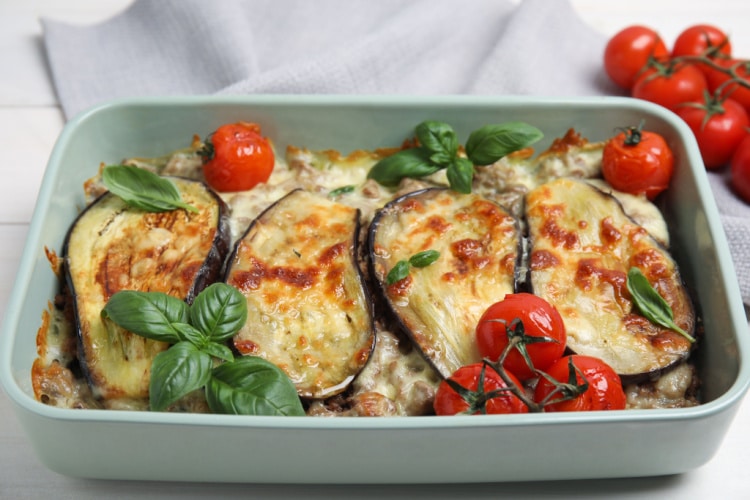
Eggplants are low in calories and starch yet high in fiber. Fiber is essential for people with diabetes and prediabetes thanks to its ability to support healthy gut function.
Eggplant has a glycemic index under 50, so even after a substantial meal, your blood sugar levels won’t rise.
One eggplant has 35 calories, 8.6 grams of carbohydrates, 2.5 grams of fiber, and 1 gram of protein.
Additionally, it’s rich in essential micronutrients, including vitamins C, K, B1, B3, B6, B9, magnesium, manganese, phosphorus, copper, potassium, and antioxidants.
How to Make Eggplant Lasagna
If you want to make your first eggplant lasagna, let’s break it down into a few easy steps.
To begin, cut 3 eggplants into long, thin strips. Lightly glaze or brush the strips with your favorite healthy oil, season with salt to lessen the bitterness, and press with a paper towel to absorb excess moisture.
Bake the eggplants until one side is golden brown, then flip over to the other side. Bake them for 20 to 25 minutes at 400 degrees Fahrenheit, 10 to 12 minutes on each side.
For the filling, mix 1 beaten egg with ricotta cheese, 1 cup shredded mozzarella, and ¼ parmesan cheese. Stir in 10 oz. finely chopped spinach. Season with minced garlic, oregano, salt, and pepper to taste. For extra richness, add some chopped parsley and basil.
Begin layering the roasted eggplants in a baking dish. Pour one layer of tomato sauce on the bottom, followed by one layer of eggplant and the filling. Repeat until you’ve run out of eggplants.
Top with a layer of tomato sauce, shredded mozzarella cheese, and parmesan. Bake for 20 minutes covered, then another 15 minutes uncovered.
3. Soba Noodles
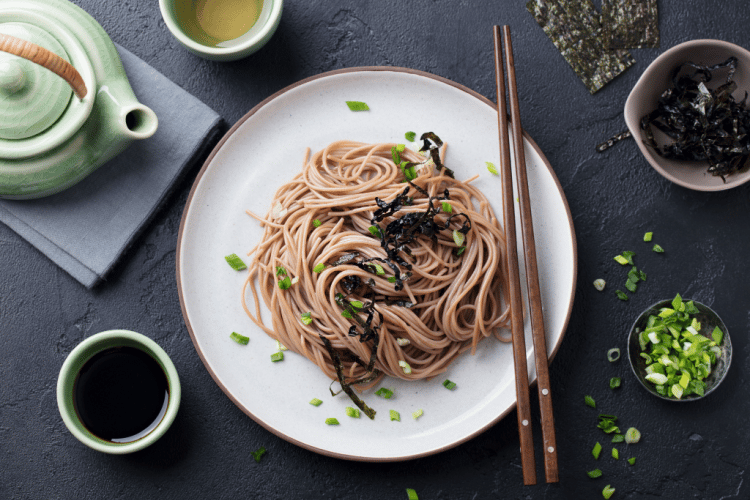
Say hello to ramen’s healthier cousin — soba noodles. Originating from Japan, soba is a buckwheat-based noodle that isn’t made of wheat.
Soba falls on the lower end of the glycemic index and contains a lot of fiber. Since it isn’t a cereal grain, there isn’t any gluten in these noodles. It’s a win-win for your blood sugar levels and gut health.
Soba has 24 g of carbohydrates per cup — which is lower than regular pasta. Plus, it’s rich in fiber that slows down the burning of carbs.
Every cup of soba contains 0.4 mg of manganese — an essential component for metabolizing glucose. On top of that, it’s rich in vitamin B1, iron, magnesium, phosphorus, potassium, and zinc.
How to Cook Soba Noodles
To get the most benefits from this noodle alternative, we recommend getting soba that’s 100% buckwheat and avoiding the ones with additives. First, boil some water in a saucepan.
Add the noodles and gently stir. Lower the heat to medium-high and cook the noodles for 7 to 8 minutes. Follow the instructions on the package if there are any.
Soba noodles are incredibly versatile, so once cooked, you can simmer them with veggies, chicken, beef, or pork. To combine the flavors, stir all the ingredients for a few minutes over medium heat. You can add kale, pesto, and mushrooms to mix things up.
4. Veggie Spaghetti
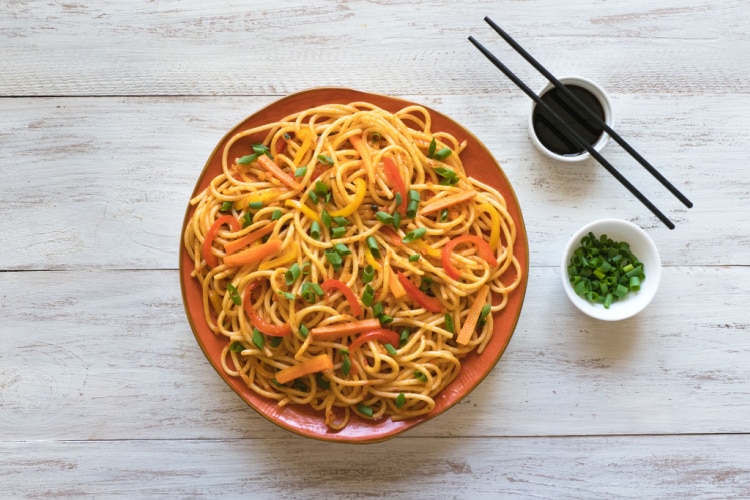
Carrot, zucchini, and squash are all veggies that can make mouth-watering pasta substitutes.
Carrots are rich in vitamin A, K1, fiber, and beta carotene. They are non-starchy vegetables and have a glycemic score of 16.
Squash has a low glycemic score of 15. It is rich in antioxidants, beta carotene, manganese, niacin, potassium, magnesium, iron, vitamins B6 and C, and many more.
Zucchini is another diabetic-friendly veggie that is loaded with dietary fiber. Plus, it ranks low on the glycemic scale, only going up to 15. Zucchini contains antioxidants, vitamins A, B6, C, K, copper, folate, manganese, magnesium, phosphorus, potassium, and thiamine.
How to Make Veggie Spaghetti
You can give these veggies a noodle-like consistency in a few simple steps.
To begin, you’ll need something to cut the vegetables into spaghetti shapes. You can use a mandoline slicer, a vegetable peeler, or a julienne peeler.
Then you fry or roast them on medium heat for around 30 minutes. Once done, you can easily add your favorite pasta sauce and seasonings and have a nice healthy meal without worrying about raising your glucose levels.
5. Cabbage Noodles
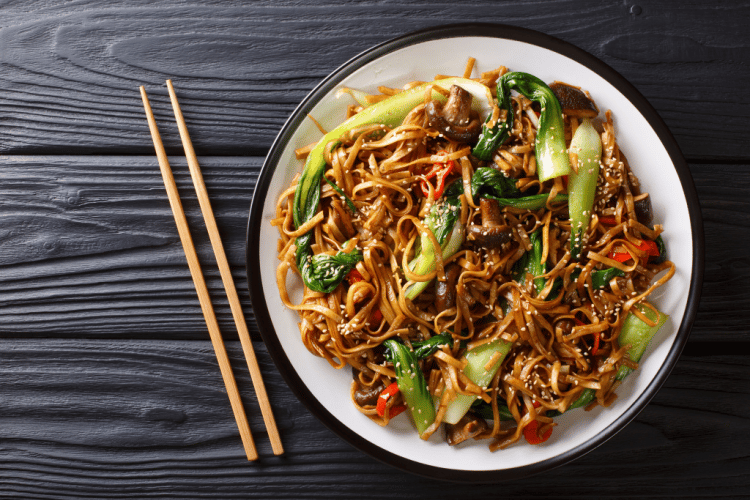
You can eat cabbage noodles without worrying about your blood sugar levels.
Cabbage is a non-starchy, high-fiber veggie, which makes it a diabetes-friendly food that can help keep your blood sugar levels in check. It has a glycemic score of 10. One cup of cabbage noodles contains 7 g of carbohydrates, 3 g of fiber, and 2 g of protein.
Not only that, but cabbage is an excellent source of nutrition, boasting around 25 vitamins and minerals, including vitamins C, K, potassium, folate, and manganese.
How to Make Cabbage Noodles
These noodles are simply strips of cabbage. You can also use cabbage leaves as an alternative to lasagna sheets.
Preheat a skillet over medium heat. When the pan is hot, add butter or oil and sauté the cabbage for about 10 minutes or until it’s soft—season with salt and pepper to taste.
You may add meat, fish, other vegetables, or even apples to your meal to make it more filling. If you add more ingredients, cook everything for a few minutes longer to allow the flavors to mingle. Give it a good stir and serve.
Can Diabetics Eat Pasta Ever Again?
The good news is that you can eat pasta on a diabetic diet. To do that, you need to follow only four simple guidelines.
- Choose a whole-grain pasta: This pasta is made from whole-wheat flour and has a lower glycemic index than refined pasta;
- Eat a smaller portion: A portion about the size of your fist or a third to a quarter of your plate;
- Serve the pasta with meat and salad: The protein will slow down the digestion of the carbs and keep your blood sugar leveled. To help you fill up, add a nice salad to your meal.
- Check your blood sugar after you have pasta: This step will ensure that the portion you’ve picked works best for your diabetes.
Conclusion
Pasta is a delicious ingredient, but it’s not always suitable for diabetics.
As I mentioned, though, there are some great alternatives to pasta.
Soba noodles are the closest to pasta in terms of appearance and taste, plus they can be paired with basically anything that comes to your mind.
I find that kelp noodles are great if you are in a hurry, as they don’t require boiling or simmering. If you prefer vegetables, try eggplant lasagna, vegetarian spaghetti, or cabbage noodles.
All in all, a person with diabetes can have pasta — just make sure it’s whole grain or one of the alternatives we suggested.
Also, eat a smaller portion, consume it with proteins and leafy greens, and check your blood sugar levels afterward to make sure you’re doing well.
Frequently Asked Questions
Pasta can affect blood sugar for 1 to 2 hours after eating, depending on the individual’s metabolism and the type of pasta.
Diabetics can eat pasta and rice in moderation, focusing on portion control and opting for whole-grain options to better manage blood sugar levels.
Egg noodles can be consumed by diabetics, but they should choose whole-grain or high-fiber varieties and monitor portion sizes to manage their blood sugar effectively.





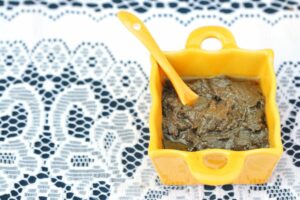

Very helpful web site for a person just getting started with diabetic diet.I saved this site,and return time and again.
Dear Rainer, thank you so much for your nice feedback and we’re all glad that you find our content useful. We’ll keep at it and thank you fore reading!